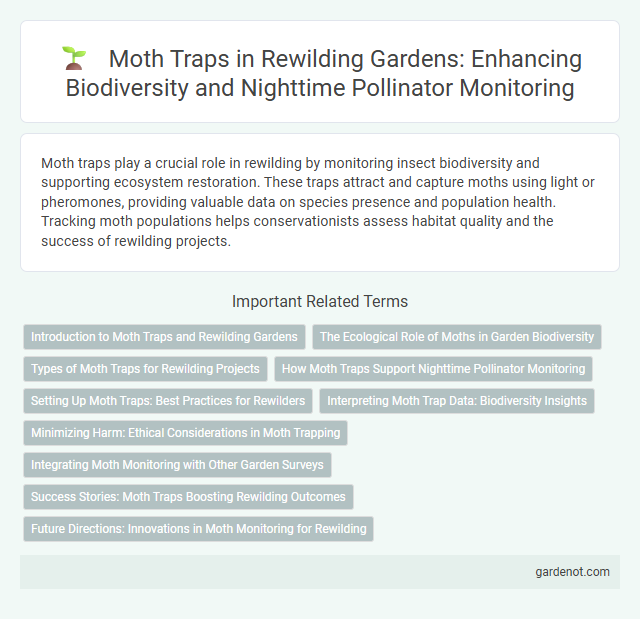Moth traps play a crucial role in rewilding by monitoring insect biodiversity and supporting ecosystem restoration. These traps attract and capture moths using light or pheromones, providing valuable data on species presence and population health. Tracking moth populations helps conservationists assess habitat quality and the success of rewilding projects.
Introduction to Moth Traps and Rewilding Gardens
Moth traps play a crucial role in rewilding gardens by monitoring nocturnal pollinators and supporting biodiversity restoration. These traps, often using UV light to attract moths, help identify species presence and population trends, informing garden management practices that encourage native flora and fauna. Integrating moth traps into rewilding projects enhances ecosystem health by fostering natural pest control and pollination processes.
The Ecological Role of Moths in Garden Biodiversity
Moth traps are essential tools for monitoring and supporting the ecological role of moths in garden biodiversity by attracting and safely capturing diverse moth species. Moths serve as vital pollinators for nocturnal plants and act as a primary food source for birds, bats, and other wildlife, enhancing ecosystem stability. Maintaining healthy moth populations through rewilding efforts promotes natural pest control and sustains intricate food webs within garden habitats.
Types of Moth Traps for Rewilding Projects
Moth traps used in rewilding projects primarily include light traps, pheromone traps, and bait traps, each designed to attract different moth species for monitoring biodiversity. Light traps use ultraviolet or mercury vapor lamps to attract nocturnal moths, making them ideal for assessing species richness in restored habitats. Pheromone traps emit synthetic chemical signals to target specific moth species, aiding in population studies and ecological balance evaluations within rewilding efforts.
How Moth Traps Support Nighttime Pollinator Monitoring
Moth traps provide crucial data for nighttime pollinator monitoring by attracting and capturing diverse moth species, enabling researchers to assess population health and biodiversity. These traps utilize light sources to lure moths, offering insights into nocturnal pollination patterns and ecosystem dynamics. Monitoring moth activity helps track environmental changes and supports conservation efforts aimed at preserving vital pollinator habitats.
Setting Up Moth Traps: Best Practices for Rewilders
Setting up moth traps involves selecting a dark, sheltered location near native vegetation to attract diverse moth species crucial for ecosystem health. Using a white sheet and UV light source enhances moth visibility, allowing rewilders to monitor species abundance and diversity effectively. Regularly checking traps at night and recording data supports biodiversity assessments and informs habitat restoration strategies.
Interpreting Moth Trap Data: Biodiversity Insights
Moth trap data offers critical insights into local biodiversity by revealing species diversity, population trends, and habitat health. Analyzing nightly catch patterns helps identify indicator species sensitive to environmental changes, aiding in effective rewilding efforts. Long-term monitoring of moth populations also supports the assessment of ecosystem resilience and guides habitat restoration strategies.
Minimizing Harm: Ethical Considerations in Moth Trapping
Ethical considerations in moth trapping prioritize minimizing harm by using non-lethal traps that allow for safe observation and release, preserving moth populations and biodiversity. Employing light sources with wavelengths less disruptive to moth behavior reduces stress and mortality rates during studies. Properly maintained traps and timely checks prevent unnecessary damage to specimens, ensuring sustainable rewilding efforts and ecological balance.
Integrating Moth Monitoring with Other Garden Surveys
Integrating moth traps with other garden surveys enhances biodiversity monitoring by providing comprehensive data on nocturnal pollinators and ecosystem health. Moth monitoring complements bird counts, butterfly surveys, and plant health assessments, revealing patterns of species interaction and environmental changes. Combining these methods supports targeted conservation strategies in rewilding projects, promoting balanced habitats and resilient ecosystems.
Success Stories: Moth Traps Boosting Rewilding Outcomes
Moth traps have proven instrumental in enhancing rewilding success by providing critical data on local moth populations, which serve as key bioindicators of ecosystem health. Projects using these traps report increased biodiversity, as moth diversity often correlates with improved habitat quality and the return of other wildlife species. This targeted monitoring enables adaptive management strategies that accelerate the restoration of native flora and fauna.
Future Directions: Innovations in Moth Monitoring for Rewilding
Emerging technologies in moth monitoring, such as AI-powered automated identification and smart light traps, are revolutionizing data collection for rewilding projects. Integration of environmental DNA (eDNA) sampling with traditional moth traps enhances species detection accuracy and biodiversity assessment. These innovations enable real-time monitoring and adaptive management, driving more effective conservation strategies in rewilding efforts.
Moth trap Infographic

 gardenot.com
gardenot.com